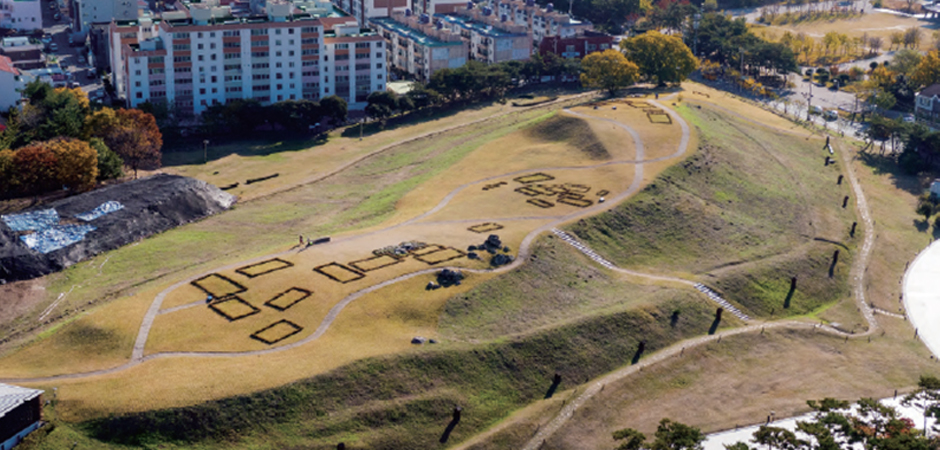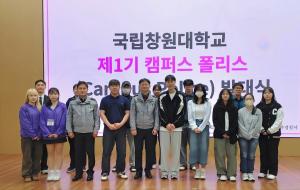 |
| ▲ A view of one of the Gaya Tumuli in Gimhae, South Gyeongsang Province (Source: World Heritage Nomination Office for Gaya Tumuli website) |
On September 17, the Gaya Tumuli, archaeological cemetery sites with burial mounds, were officially inscribed on the UNESCO World Heritage List at the 45th session of the World Heritage Committee held in Riyadh, Saudi Arabia. South Gyeongsang Province has worked diligently for ten years to achieve this recognition. The long journey began in December 2013, when they submitted an application to the Cultural Heritage Administration to include the Gaya Tumuli on UNESCO’s Tentative List of World Heritage Sites. In May of this year, the Gaya Tumuli were recommended for inscription on the World Heritage List by the International Council on Monuments and Sites (ICOMOS), an advisory body to UNESCO. Finally, on September 17, the inscription was confirmed, making it the 16th World Heritage Site in South Korea.
The sites of the Gaya Tumuli are located in Kimhae, Haman, Hapcheon, Goryeong, Goseong, Changnyeong, and Namwon. They are unique evidence of the civilization of the Gaya Confederacy from the 1st to the 6th centuries. Although Gaya developed in the southern part of the Korean Peninsula for over 500 years, historical records are scarce. Therefore, the Gaya Tumuli play an important role in researching and reconstructing the history of Gaya. The various artifacts and remains, including earthenware and jewelry, are invaluable academic materials that provide a profound understanding of Gaya's culture and history. Recognized for its artistic value and historical significance, the Gaya Tumuli was inscribed on the World Heritage List, meeting one of the criteria for inscription: "To bear a unique or at least exceptional testimony to a cultural tradition or to a civilization which is living, or which has disappeared." Furthermore, through their geographical distribution and landscape characteristics, types of burials, and grave goods, the cemeteries attest to the distinctive Gaya political system, in which polities existed as autonomous political equals while sharing cultural commonalities. This highlights their important role in representing the type of ancient civilization in East Asia.
Each tomb is of substantial size, reflecting the scenic and spatial characteristics and the formation process of the heritage, while preserving the outstanding universal value of the site. In addition, it maintains a high level of authenticity in its shape and surroundings. This is because the excavation of the tombs is minimized for academic purposes, and the restoration and maintenance of the site are carried out within boundaries that do not affect authenticity. As a result, the Gaya Tumuli have been recognized as a World Heritage Site for current and future generations.
The remaining challenge is to systematically preserve the history of Gaya, which has received less attention than the Goguryeo, Baekje, and Silla kingdoms due to a lack of historical records. The Gaya Tumuli will be supported in various fields through projects to preserve, manage, and utilize the site under the “Special Act on the Preservation, Management, and Utilization of World Heritage Sites.” The South Gyeongsang Province plans to preserve the Gaya Tumuli in their entirety while creating a historical and cultural zone that actively utilizes the tombs to promote Gaya Tumuli's history globally and attract local and international visitors. In addition, it is planned to enhance the tourism capacity of South Gyeongsang Province by activating a part of the Gaya Tumuli as a representative cultural heritage site of South Gyeongsang Province, in connection with the South Coast Tourism Belt. This is expected to have a positive impact on the tourism industry by providing visitors with the opportunity to explore the Gaya Tumuli.
The inscription of the Gaya Tumuli on the World Heritage List is expected to enhance South Korea's position and expand the opportunities to share Korean history and culture with the world. The process to achieve this recognition was the result of collaborative research and efforts by international scholars, allowing Korea’s history and culture to be showcased on a global stage. Park Wan- soo, the South Gyeongsang Governor said, "The inscription of the Gaya Tumuli on the World Heritage List acknowledges the value of the Gaya civilization worldwide.” He added, “We must work closely with the government to effectively manage and increase the value of the Gaya Tumuli." In order to accelerate the process of preserving and developing our heritage, please give a lot of support and show your interest in the Gaya Tumuli.
By Park Jeong-hyeon, reporter jhgongju0903@gmail.com
<저작권자 © The Campus Journal, 무단 전재 및 재배포 금지>

 Shrinkflation, Consumer Deception
Shrinkflation, Consumer Deception




